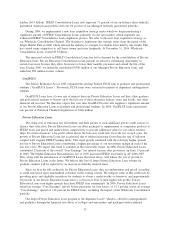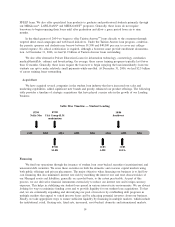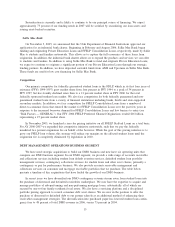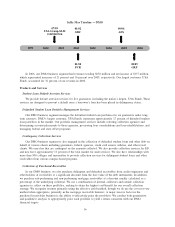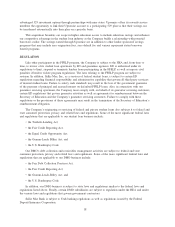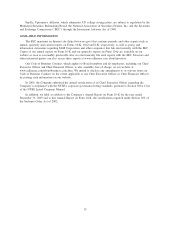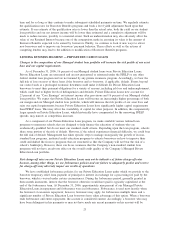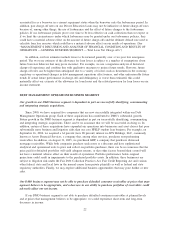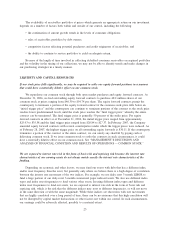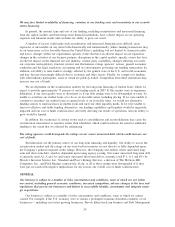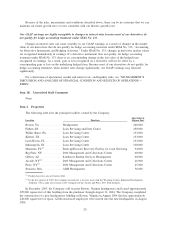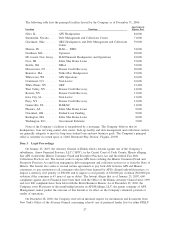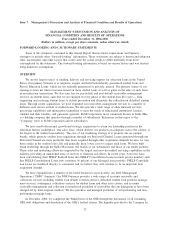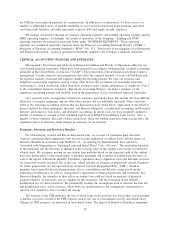Sallie Mae 2006 Annual Report Download - page 24
Download and view the complete annual report
Please find page 24 of the 2006 Sallie Mae annual report below. You can navigate through the pages in the report by either clicking on the pages listed below, or by using the keyword search tool below to find specific information within the annual report.The availability of receivables portfolios at prices which generate an appropriate return on our investment
depends on a number of factors both within and outside of our control, including the following:
• the continuation of current growth trends in the levels of consumer obligations;
• sales of receivables portfolios by debt owners;
• competitive factors affecting potential purchasers and credit originators of receivables; and
• the ability to continue to service portfolios to yield an adequate return.
Because of the length of time involved in collecting defaulted consumer receivables on acquired portfolios
and the volatility in the timing of our collections, we may not be able to identify trends and make changes in
our purchasing strategies in a timely manner.
LIQUIDITY AND CAPITAL RESOURCES
If our stock price falls significantly, we may be required to settle our equity forward positions in a manner
that could have a materially dilutive effect on our common stock.
We repurchase our common stock through both open market purchases and equity forward contracts. At
December 31, 2006, we had outstanding equity forward contracts to purchase 48.2 million shares of our
common stock at prices ranging from $46.30 to $54.74 per share. The equity forward contracts permit the
counterparty to terminate a portion of the equity forward contract if the common stock price falls below an
“initial trigger price” and the counterparty can continue to terminate portions of the contract as the stock price
reaches lower predetermined levels, until the stock price reaches the “final trigger price” whereby the entire
contract can be terminated. The final trigger price is generally 50 percent of the strike price. For equity
forward contracts in effect as of December 31, 2006, the initial trigger price ranged from approximately
$25.93 to $35.58 and the final trigger price ranged from $20.84 to $27.37. In February 2007, the Company
amended equity forward contracts with several counterparties under which the trigger prices were reduced. As
of February 28, 2007, the highest trigger price on all outstanding equity forwards is $30.11. If the counterparty
terminates a portion of the contract or the entire contract, we can satisfy any shortfall by paying cash or
delivering common stock. If we issue common stock to settle the contracts in such circumstances, it could
have a materially dilutive effect on our common stock. See “MANAGEMENT’S DISCUSSION AND
ANALYSIS OF FINANCIAL CONDITION AND RESULTS OF OPERATIONS — COMMON STOCK.”
We are exposed to interest rate risk in the form of basis risk and repricing risk because the interest rate
characteristics of our earning assets do not always match exactly the interest rate characteristics of the
funding.
Depending on economic and other factors, we may fund our assets with debt that has a different index
and/or reset frequency than the asset, but generally only where we believe there is a high degree of correlation
between the interest rate movement of the two indices. For example, we use daily reset 3-month LIBOR to
fund a large portion of our daily reset 3-month commercial paper indexed assets. We also use different index
types and index reset frequencies to fund various other assets. In using different index types and different
index reset frequencies to fund our assets, we are exposed to interest rate risk in the form of basis risk and
repricing risk, which is the risk that the different indices may reset at different frequencies, or will not move
in the same direction or with the same magnitude. While these indices are short-term with rate movements
that are highly correlated over a long period of time, there can be no assurance that this high correlation will
not be disrupted by capital market dislocations or other factors not within our control. In such circumstances,
our earnings could be adversely affected, possibly to a material extent.
23


